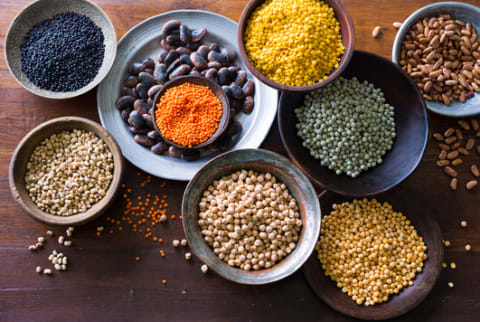Advertisement

You might not hear much about lectins these days. There is limited research on how these plant proteins affect people, but those with digestive issues might want to pay close attention. (To read more about the lectin-free diet, check out our full explainer here.)
Lectins, as people with sensitivities might tell you, can be hard to digest—which can become problematic, as they are found in so many foods.
What are lectins?
Lectins are specialized proteins found in all plants and plant seeds. Lectins act as a deterrent against creatures consuming plants or seeds by binding to carbohydrate molecules present in cell membranes within the gut. This action disrupts the cell membranes, irritating the gut lining and causing the creature to think twice about ever eating those plants or seeds again.
Of course, humans have been eating plants since the dawn of time (less so with seeds, however). As a result, humans have developed a natural protection against lectins. The lining of the gut is coated with a protective barrier of carbohydrate molecules, or mucus. These molecules act like decoys that neutralize the plant lectins. Even so, high concentrations of lectins can still cause a lot of damage to people with food sensitivities
Problematic lectins can be found in these primary sources:
- Grains (especially wheat and corn)
- Beans/legumes, especially soybeans, kidney beans, black beans, and peanuts
- Tree nuts, such as almonds, pecans, walnuts, cashews, and pistachios
- Nightshade vegetables, including tomatoes, potatoes, eggplant, and peppers
- Dairy products from cows raised on corn and soybeans
In other words, lectins are found in the foods that many Americans eat every day! For more lectin-containing foods, check out our full list here.
Are lectins the same as gluten?
Both lectin proteins and gluten proteins have the potential to damage the gut lining, but they're not the same. Lectin proteins are found in the outer protective covering of the seed, called bran. Whole-grain products are actually high in lectins.
Gluten is a plant storage protein found in the seed's endosperm; it stores amino acids necessary for the seed to sprout. Because plant storage proteins are structured differently from animal proteins, they can be hard to digest and can irritate the intestinal tract of animals. While all seeds contain storage proteins, gluten proteins can be the most irritating.
While lectins and gluten are distinct, our approach to them is somewhat similar. Just as how you would avoid gluten if you're gluten intolerant, you might want to avoid lectins if you think you might have a sensitivity. On the other hand, if you can tolerate lectins just fine, there's no reason to steer clear—just as someone who isn't gluten intolerant might incorporate gluten into their lifestyle.
And with both lectins and gluten, stress can worsen the situation. Stress can slows down movement within the intestinal tract, which can intensify the damage from lectins and gluten proteins.
What should you eat if you're sensitive to lectins?
Plant lectins aren't nearly as much of a problem as seed lectins, since humans are more adapted to eating plants over seeds. For this and many other reasons, keep the following in mind:
Vegetables
At least half of your food should come from vegetables. Also, you might want to cook most of your food, since cooking can help break down lectins (steaming vegetables is a great way to break down lectins yet retain nutrients!).
Protein
Fish, eggs, and poultry don't contain lectins, so they're the best source of protein for a lectin-free lifestyle (red meat is a bit harder to digest).
While seeds are protein-rich, because of the lectin content, they shouldn't make up any significant portion of your diet if you're trying to go lectin-free.
Grains, beans, and legumes
Lectins can be reduced (but not eliminated) in grains by sprouting and boiling. Baking, however, doesn't significantly reduce the amount of lectins or gluten in wheat products.
Lectins can be reduced in beans by extended soaking, fermenting, or prolonged boiling (raw and/or sprouted kidney beans are actually poisonous because of their high lectin content). Fermented soybean products, such as tempeh, are lower in lectins than other soy products.
Fortunately, there is an exception to every rule: white rice. The lectins and storage proteins in white rice have a lower potential for harm. The carbohydrates in rice are broken down completely and typically don't contribute to bacterial overgrowth in the gut.
As always, it's best to consult a doctor or dietitian before starting any restrictive diet. While there are little clinical trials to say whether lectins are "good" or "bad," if you find yourself sensitive to lectin-containing foods, experimenting with a lectin-free diet may be beneficial. You know your body best—so feel free to eat or avoid what feels right for you, whether it's lectins or not.

